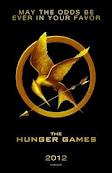 Well, I read it. Then I went to see the movie with my husband, who actually stayed awake through the whole thing, and then pronounced it “interesting.” (This is a man who dozed off in the middle of Avatar in 3D.) It was interesting. And disturbing.
Well, I read it. Then I went to see the movie with my husband, who actually stayed awake through the whole thing, and then pronounced it “interesting.” (This is a man who dozed off in the middle of Avatar in 3D.) It was interesting. And disturbing.
The Hunger Games was originally published in 2008. The movie has now launched it into the cultural stratosphere.
Briefly, the setting is somewhere in the future. The United States is now Panem, a surreal Capitol surrounded by 12 struggling districts. Once a year, each district must send a boy and a girl, between the ages of 12 and 18, to The Hunger Games. The Games take place at the Capitol inside an immense theater (think The Truman Show). Recreated as a rugged wilderness, the “Tributes” fight to the death until only one survives. The arena is filled with hidden cameras, and everyone in the Capitol and the Districts can watch – and even place bets on the winner.
Pretty clever stuff, right? I can’t quibble with the creative skill. And I can’t help but like the main character, 16 year old Katniss Everdeen. Author Suzanne Collins creates a tough, resourceful, and self-sacrificing young woman. When her sister’s name is drawn as their district’s female Tribute, Katniss offers herself instead. Commendable, considering the horrific task ahead.
Yes, there’s plenty of weird, bizarre stuff, and it’s an interesting plotline. But, and this is where I part company with the Love This Book! Such a Great Movie! fans, I had to deliberately keep reminding myself that the underlying theme of book and movie is kids killing kids.
They are under the control of abominable adults, you say. Okay, I get that.
But consider this scene where Katniss is thinking about the “list of kills”:
‘The boy from District 1 was the first person I knew would die because of my actions. Numerous animals have lost their lives at my hands, but only one human. I hear Gale [a friend back home] saying, How different can it be, really? Amazingly similar in the execution. Entirely different in the aftermath. I killed a boy whose name I don’t even know. But then I think of Rue’s [a 12 year old tribute killed by this boy] body and I’m able to banish the boy from my mind. At least, for now.’
This is obviously not Lord of the Flies. There is very little thoughtful reflection or emotion in the terrible ritual of slaughter. I think this is what bothers me most. Collins has written the book at high school level and could have created characters who think seriously about what they are actually doing and what it actually means.
Instead, we get this exchange between Katniss and her partner, Peeta:
‘My best hope is to not disgrace myself and . . .’ He hesitates.
‘And what?’ I say.
‘I don’t know how to say it exactly. Only . . . I want to die as myself. Does that make any sense?’ he asks. ‘I don’t want them to change me in there. Turn me into some kind of monster that I’m not.’
I bite my lip feeling inferior. While I’ve been ruminating on the availability of trees, Peeta has been struggling with how to maintain his identity. His purity of self.
Purity of self? Here is an opportunity to talk about the value of life, the sanctity and preciousness of it, for everyone, including all the kids pitted against each other. Instead we get “I just wanna be me.”
The flyleaf breathlessly describes this as a “searing novel set in a future with unsettling parallels to our present.” Really? Where in your present or mine are teenagers fighting to the death in a manmade arena at the behest of adults?
However, it does provide a great opportunity for parents to discuss the big themes in the book, and those important things that might be missing. For those of you who have read the book or seen the movie, I’d love to have you post your responses here. Do you have questions you think would make for good discussion with teens? I invite you to post them, also.




